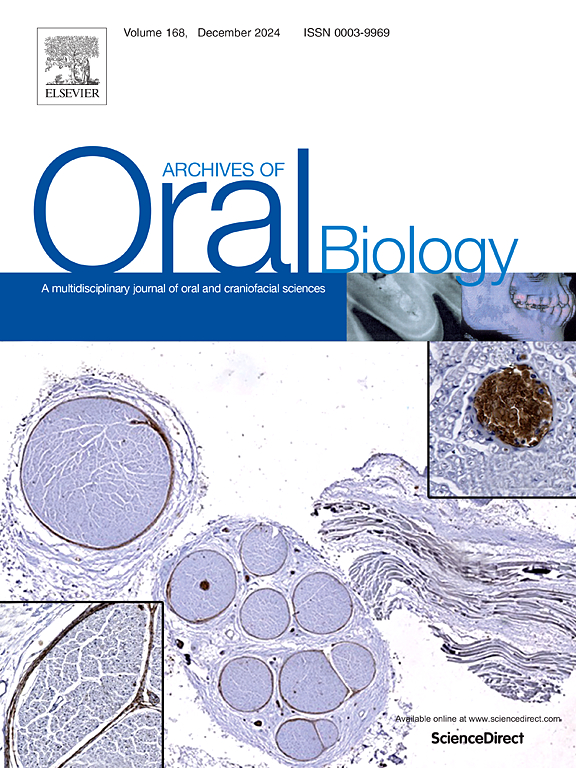Chemical and morphological analysis of permeable dentin exposed to experimental solutions containing epigallocatechin-3-gallate encapsulated in chitosan nanoparticles
IF 2.1
4区 医学
Q2 DENTISTRY, ORAL SURGERY & MEDICINE
引用次数: 0
Abstract
Objective
To evaluate the effects of epigallocatechin 3-gallate (EGCG) and chitosan-based solutions on the chemical and morphological structure of permeable dentin using Fourier Transform Infrared Spectroscopy with Attenuated Reflectance Accessory (FTIR-ATR), Energy dispersive X-ray spectroscopy – EDS, and Scanning Electron Microscopy (SEM) analyses.
Design
Bovine root dentin specimens were demineralized with EDTA to simulate dentin hypersensitivity. Specimens were divided into six groups (n = 6): EGCG encapsulated in chitosan nanoparticles (Nchi + EGCG), chitosan nanoparticles (Nchi), EGCG, Elmex Sensitive, deionized water (negative control), and No solution/no acid challenge. Solutions were applied, followed by cycles of citric acid (2 min, 0.3 %, pH 2.45) and artificial saliva (1 h, 4 ×/7 days). Data were analyzed using Kolmogorov-Smirnov, ANOVA, and Tukey’s tests.
Results
FTIR spectra revealed enhanced phosphate, carbonate, and amide bands in Nchi + EGCG, EGCG, Nchi, and Elmex groups. EDS showed no significant differences in Ca/P ratios among treated groups, but Nchi and Nchi + EGCG differed significantly from the No solution/no acid challenge (p < 0.05). There were significant differences in the number of dentinal tubules between the Nchi/Nchi + EGCG and EGCG/No solution applied groups (P < 0.05), but no differences among experimental solutions and negative control (p > 0.05). Nchi + EGCG and EGCG showed the smallest open dentinal tubule areas (P = 0.00 and P = 0.001, respectively).
Conclusion
Nchi + EGCG modified dentin by enhancing collagen interaction; however, it does not alter Ca/P ratio. Solutions containing EGCG (EGCG and Nchi + EGCG) can reduce the open tubule area.
壳聚糖纳米颗粒包封表没食子儿茶素-3-没食子酸酯实验溶液中可渗透牙本质的化学和形态学分析
目的利用傅里叶变换红外光谱(FTIR-ATR)、x射线能谱仪(EDS)和扫描电镜(SEM)分析评价表没食子儿茶素3-没食子酸酯(EGCG)和壳聚糖溶液对可渗透牙本质化学和形态结构的影响。设计用EDTA对牛牙根进行脱矿处理,模拟牙本质过敏反应。将标本分为6组(n = 6):壳聚糖纳米粒包封EGCG (Nchi + EGCG)、壳聚糖纳米粒(Nchi)、EGCG、Elmex Sensitive、去离子水(阴性对照)和无溶液/无酸刺激。应用溶液,然后循环柠檬酸(2 min, 0.3 %,pH 2.45)和人工唾液(1 h, 4 ×/7天)。数据分析采用Kolmogorov-Smirnov、ANOVA和Tukey检验。结果ftir光谱显示Nchi + EGCG、EGCG、Nchi和Elmex基团的磷酸盐、碳酸盐和酰胺带增强。EDS各组Ca/P比值差异不显著,但Nchi和Nchi + EGCG与无溶液/无酸激发组差异显著(P <; 0.05)。Nchi/Nchi + EGCG组与EGCG/No溶液组牙髓小管数量差异有统计学意义(P <; 0.05),但实验溶液与阴性对照组间差异无统计学意义(P >; 0.05)。Nchi + EGCG和EGCG的牙髓小管开放面积最小(P分别为 = 0.00和P = 0.001)。结论nchi + EGCG通过增强胶原相互作用修饰牙本质;然而,它不改变钙磷比。含有EGCG的溶液(EGCG和Nchi + EGCG)可以减少开管面积。
本文章由计算机程序翻译,如有差异,请以英文原文为准。
求助全文
约1分钟内获得全文
求助全文
来源期刊

Archives of oral biology
医学-牙科与口腔外科
CiteScore
5.10
自引率
3.30%
发文量
177
审稿时长
26 days
期刊介绍:
Archives of Oral Biology is an international journal which aims to publish papers of the highest scientific quality in the oral and craniofacial sciences. The journal is particularly interested in research which advances knowledge in the mechanisms of craniofacial development and disease, including:
Cell and molecular biology
Molecular genetics
Immunology
Pathogenesis
Cellular microbiology
Embryology
Syndromology
Forensic dentistry
 求助内容:
求助内容: 应助结果提醒方式:
应助结果提醒方式:


